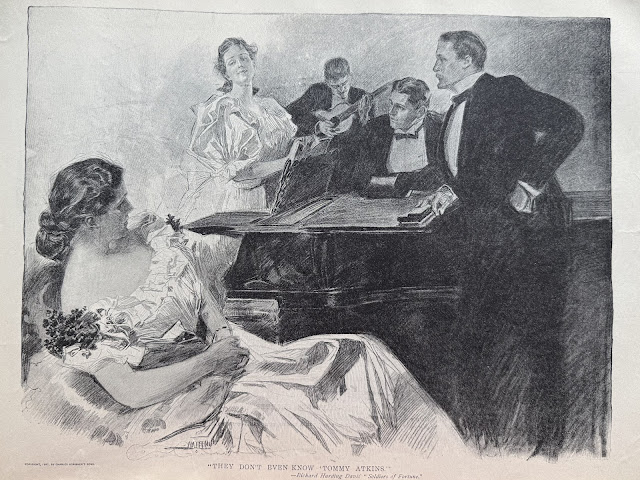Before there were movie stars, fashionistas, and influencers, there was the Gibson Girl—a pen-and-ink phenomenon who captivated America at the turn of the 20th century. Tall, poised, stylish, and independent, she was the idealized image of modern womanhood created by illustrator Charles Dana Gibson.
But she was more than a drawing. She was a cultural icon who both reflected and shaped the aspirations of a generation of women.
A New Kind of Beauty
The Gibson Girl made her debut in the 1890s, gracing the pages of Life, Collier’s, and Harper’s Weekly. She reflected the era’s beauty ideal: a slim waist shaped by a swan-bill corset, an elegant S-curve silhouette, and voluminous updos like pompadours or chignons.
Unlike the fragile Victorian ideal of earlier decades, the Gibson Girl exuded self-assurance. She wasn’t a suffragist or a radical, but she was unmistakably modern. Often shown in fashionable outfits that signaled her upper-middle-class status, she embraced outdoor activities like cycling, valued education, and sometimes even entered the workforce.
But she was more than a drawing. She was a cultural icon who both reflected and shaped the aspirations of a generation of women.
A New Kind of Beauty
The Gibson Girl made her debut in the 1890s, gracing the pages of Life, Collier’s, and Harper’s Weekly. She reflected the era’s beauty ideal: a slim waist shaped by a swan-bill corset, an elegant S-curve silhouette, and voluminous updos like pompadours or chignons.
Unlike the fragile Victorian ideal of earlier decades, the Gibson Girl exuded self-assurance. She wasn’t a suffragist or a radical, but she was unmistakably modern. Often shown in fashionable outfits that signaled her upper-middle-class status, she embraced outdoor activities like cycling, valued education, and sometimes even entered the workforce.
 | |||||
| AT THE OPERA |
He fails to take a friendly interest in the great composers
 | |||||
| ADVICE TO BEGINNERS |
Keep close to nature.
Brains, Beauty, and a Bit of Attitude
Gibson’s illustrations captured women who were witty, spirited, and just a little aloof. They towered over bumbling suitors, debated politics with charm, and weren’t afraid to scoff at convention. These images suggested that beauty and brains could coexist—a bold notion at the time.
Gibson’s illustrations captured women who were witty, spirited, and just a little aloof. They towered over bumbling suitors, debated politics with charm, and weren’t afraid to scoff at convention. These images suggested that beauty and brains could coexist—a bold notion at the time.
 |
| "The don't even know 'Tommy Atkins'" |
 |
| Under the Microscope: The Weaker Sex |
Fashion designers embraced the look. High collars, flowing skirts, and the famous Gibson hairstyle quickly became all the rage. As women stepped into new roles as students, workers, and athletes they carried her image with them. She was part fantasy, part aspiration, and very influential.
The Women Behind the Drawings
Many women served as inspiration for Gibson Girl illustrations, including Charles Dana Gibson’s own wife, Irene Langhorne (pictured below, far left), who is often considered one of the earliest muses. She was also the sister of Nancy Langhorne Astor, the first woman to take a seat in the British Parliament. Other notable models included actresses and performers such as Mabel Normand, Evelyn Nesbit (pictured middle), Minnie Clark, and Clara B. Fayette. The most iconic of them all was stage actress Camille Clifford (pictured far right), whose towering hairstyle, sweeping gowns, and tightly corseted figure came to embody the classic Gibson Girl look.
Enter the Christy Girl: Color, Energy, and Modern Appeal
Building on Gibson’s legacy, artist Howard Chandler Christy introduced the Christy Girl—a vibrant, athletic evolution of the Gibson Girl.
While Gibson’s pen-and-ink drawings were designed for the black-and-white printing of late 19th-century magazines, Christy rose to fame just as color printing technology improved. He embraced watercolor and oils, producing dazzling full-color posters and magazine covers that leapt off the page.
The public responded enthusiastically. His vivid use of color captivated the imagination even more, bringing his idealized heroines to life in a way that felt fresh, patriotic, and unforgettable.
Building on Gibson’s legacy, artist Howard Chandler Christy introduced the Christy Girl—a vibrant, athletic evolution of the Gibson Girl.
While Gibson’s pen-and-ink drawings were designed for the black-and-white printing of late 19th-century magazines, Christy rose to fame just as color printing technology improved. He embraced watercolor and oils, producing dazzling full-color posters and magazine covers that leapt off the page.
The public responded enthusiastically. His vivid use of color captivated the imagination even more, bringing his idealized heroines to life in a way that felt fresh, patriotic, and unforgettable.
 |
| Post cards from 1906-1910 featuring Christy's paintings |
More Than a Pretty Face
By the 1910s, with the rise of the suffrage movement and the looming shadow of World War I, the Gibson Girl began to fade. She was soon replaced by new icons like the flapper, who represented a bolder and more rebellious spirit.
In the end, the Gibson Girl wasn’t just a pretty face. She was a symbol of transition—a graceful bridge between the corseted constraints of the past and the freer spirit of the new century. She proved that a woman could be charming and clever, poised and opinionated.
And though she never spoke a word, she started a conversation that echoed long after the ink dried.
(Photo credits: All photos of Gibson and Christy works: ©KimberlyKeagan.com. All other photos courtesy of Wikipedia.)
About the Author:
Kimberly Keagan is a former corporate financial writer (not very romantic) who now crafts historical romances filled with strong heroines, swoon-worthy heroes, faith, and a touch of humor. Her Gilded Age romance, Perfect, is her debut novel.



Thank you for posting. I didn't know about the Christy Girl. I love the color in those illustrations, but I enjoy the Gibson Girl too.
ReplyDeleteThanks! Yes, the Christy paintings are lovely!
ReplyDelete